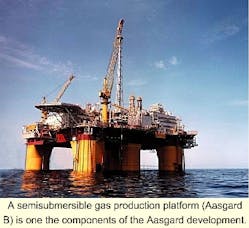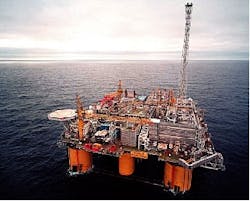A data warehouse, based on Intergraph Corp.'s Notia software, provides an extensive portfolio of e-engineering applications for creating, browsing, and maintaining facility data on Statoil's Aasgard project.
The warehouse was developed as a joint project between Statoil and Intergraph to develop and implement a web-enabled, standards-based system that addresses the access, management, and administration of technical plant information. Its plant information management (PIM) data warehouse holds all technical as-built data for the Aasgard facilities off Norway.
Aasgard
Aasgard is the largest subsea development in the world, with US $4.4 billion being invested in facilities, according to Intergraph. The project includes a floating, production, storage, and offloading vessel (Aasgard A), a semisubmersible gas production platform (Aasgard B), a storage vessel (Aasgard C), and 16 subsea templates.
The project lies about 200 km off Norway and is expected to produce about 12 billion cu m/year of gas.
Statoil says its objectives for the data warehouse were to collect and store all the plant as-built data, 80% of which is technical, for reuse throughout the long commissioning, operations, and maintenance life cycle. It is expected to attain the following objectives:
- Shorten time to first oil and gas production.
- Introduce improved work processes across the value chain via a common web portal.
- Increase operating efficiency.
- Maintain operating licenses, safe operation, and HSE (health, safety, and environment) compliance.
- Shorten costly plant shutdowns for maintenance and repairs.
- Reduce spare-equipment inventory.
- Reduce data hand-over costs from contractors and suppliers.
- Ensure data longevity and reuse of data for the entire life of the plant.
- Integrate technical data with other business systems.
The warehouse collected plant information from numerous sources and integrated it into a single, consistent form. Intergraph says with that successfully achieved, the information is easily shared and exchanged among the thousands of people and many companies authorized to use it, whenever they need it, and wherever they are located.
PIM software
Initially, Statoil collaborated with Norsk Hydro AS and Saga Petroleum AS in a joint-industry project that wanted to acquire suitable software for a standards-based data warehouse. Intergraph was contracted to develop and supply its Notia software at a fixed price and by the target date of August 1997.
Intergaph describes Notia as the data management core of Statoil's PIM that has a standard format for data representation, and this facilitates the sharing and exchange of information among many applications and users.
Notia is based on the POSC/Caesar (P/C) product model and will be migrated to the EPISTLE core model as an implementation of the ISO 15926 P/C standard for plant information. Intergraph says it embodies the neutrality, openness, and longevity inherent in STEP-based technologies. It is a mechanism capable of defining a plant configuration in a way that is independent of any proprietary system.
Intergraph obtained much of the original data from the engineering contractor, Kvaerner Oil & Gas, and more data from the equipment suppliers and subcontractors.
Applications
Both Statoil and Intergraph began developing the applications needed to find data in the warehouse.
Intergraph says the first set of applications included PIM in procurement including standard (catalog) equipment data sheets, PIM structure manager and tag manager, PIM with 2D browser and 3D web interface, PIM document administration, and PIM change management.
Statoil decided these and other applications needed to be commercialized. In July 1999, it gave Intergraph ownership of the applications as well as a $2 million software and services contract to continue Notia development and to work in partnership to build a larger set of commercial off-the-shelf (COTS) applications. Intergraph describes the included modules as follows:
- Web interface. An intuitive web-based graphical user interface became a necessity because most users are geographically dispersed. In addition to simplifying access by users, the web interface has reduced substantially the need for system training and support, thus speeding PIM's deployment.
- Procurement manager. Statoil believes the procurement manager provided a "quick win." It manages all the equipment catalog data and cuts data duplication and unnecessary equipment variants. It reduced the volume of equipment documentation by more than 80%. Data sheets are formatted to industry or ISO specifications, and Notia ensures people use only up-to-date information. It also limits inventory and waste.
- Structure manager and tag; asset manager. The structure manager and tag and asset manager relate equipment tags with the associated data and documents. It uses the POSC/Caesar effective date to manage the process and geographical configuration of the plant at all times throughout its life.
- Document management. Notia is a data-centric solution. Most documents are created on demand by applications, and therefore reports are generated directly from current and validated data.
Intergraph's Directa document management system was added and linked to Notia to help manage the engineering documents produced, their attributes, and links to the data. It also controls security, access, and revisions.
- Change manager. Engineering changes represent much of the on-going work associated within the design development, construction, and commissioning phases, but changes continue to proliferate during plant operation and maintenance. Managing changes is always costly and error-prone due to the complex interrelationships that exist among plant items, the data and documents, and all the participants in the project.
The PIM change manager tracks the details and status of each change and manages the work processes for their approval and implementation. Statoil believes that savings made using this application alone could justify the total expenditure on the PIM solution.
- 2D graphical interface and 3D interface. The 2D schematics such as PFDs (process flow diagrams) and P&IDs (process and instrumentation diagrams) are linked with the underlying data, so that these have become "intelligent" documents and a means of accessing data in the warehouse.
A 3D plant model, created by Intergraph PDS or other CAD (computer assisted design) system, can be linked to the plant data in a similar manner. These interfaces are useful for planning changes, examining access to equipment, and for planning maintenance work.
- Integration with SAP and Statoil's piping inspection system. Statoil has adopted SAP R/3 to manage the financial and resource information for maintenance and materials management on its projects. PIM and SAP are the two critical information sources, and so Statoil and Intergraph are jointly developing a bidirectional interface to link them.
A similar interface is being implemented to Statoil's proprietary piping inspection system.
- Instrument loop administration. The instrument loop administration application links Intergraph's INtools software with Notia to build and maintain the configuration of loops and control instrumentation. To date, there are almost 10,000 loop drawings for Aasgard B alone. Data accuracy here prevents costly plant shutdowns.
- Electrical distribution network administration. The electrical distribution network administration helps maintain the detailed topology of electricity distribution networks, from generators to power consumers such as motors and instruments.
Achievements
Intergraph says use of PIM within the plant commissioning and operations phases has already started, and most as-built data are loaded, with the data handover process being simply introducing new people to the PIM system. It expects use to expand rapidly among Statoil's own operations staff, as well as among external equipment suppliers and contractors, currently totaling about 3,000 people.
Statoil believes it has achieved its original aim of gaining payback on the PIM investment within 2 years. It says benefits already earned are three times their original estimates. One of its estimates indicates that a PIM can potentially save up to 30-40% of a plant's cost and reduce operating costs by 10-20%.




